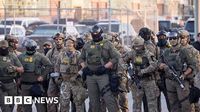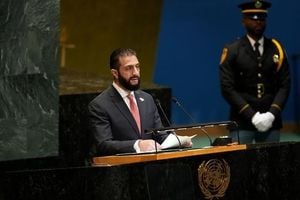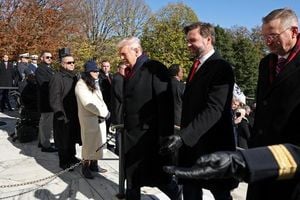In a dramatic escalation of federal intervention in local affairs, President Donald Trump’s administration has authorized the deployment of National Guard troops to major U.S. cities, sparking fierce legal and political battles. On October 4, 2025, U.S. District Judge Karin Immergut issued a temporary restraining order blocking the Trump administration from federalizing 200 Oregon National Guard troops in Portland, Oregon. The decision, prompted by a lawsuit from the state and city, has reignited debate over the boundaries of federal power and state sovereignty—a debate that’s now reverberating in Chicago, where 300 Illinois National Guard troops have been called up under similar circumstances.
The controversy began when the Trump administration announced plans to send 200 Oregon National Guard troops to Portland to protect federal buildings, citing what President Trump described as a “war-ravaged” city. According to the Associated Press, Oregon officials dismissed this characterization as “ludicrous,” noting that the protests in Portland had been relatively limited in size and scope. In her ruling, Judge Immergut, a Trump appointee, wrote, “This country has a longstanding and foundational tradition of resistance to government overreach, especially in the form of military intrusion into civil affairs.” She added, “This historical tradition boils down to a simple proposition: this is a nation of Constitutional law, not martial law.”
Judge Immergut’s order, which remains in effect until at least October 18, 2025, came after plaintiffs demonstrated that the protests—centered around the U.S. Immigration and Customs Enforcement (ICE) building—were small and “uneventful.” In her view, the president’s determination to deploy troops was “simply untethered to the facts.” The protests, which typically involved a couple dozen people, only grew to about 400 after the announcement of the deployment, according to police reports cited by the AP. Federal agents responded to these larger demonstrations with tear gas and pepper balls, arresting at least six people as tensions flared outside the ICE facility.
Portland’s Police Bureau, which does not participate in immigration enforcement, reported that their involvement was limited to instances of vandalism or criminal activity. A peaceful march earlier that day drew thousands but resulted in no arrests. However, later in the evening, federal agents again used tear gas on a crowd of about 100 people. The city’s protests have largely been confined to a one-block area in a city of 145 square miles and 636,000 residents.
The White House, undeterred by the judge’s ruling, quickly filed a notice of appeal to the 9th U.S. Circuit Court of Appeals. White House spokesperson Abigail Jackson defended the administration’s actions, stating, “President Trump exercised his lawful authority to protect federal assets and personnel in Portland following violent riots and attacks on law enforcement — we expect to be vindicated by a higher court.”
Oregon Attorney General Dan Rayfield praised the ruling as “a healthy check on the president,” adding, “It reaffirms what we already knew: Portland is not the president’s war-torn fantasy. Our city is not ravaged, and there is no rebellion. Members of the Oregon National Guard are not a tool for him to use in his political theater.”
The Portland dispute is not an isolated case. The Trump administration’s strategy of deploying federal troops has touched cities across the country, often those with Democratic leadership. In Chicago, the federal government authorized the deployment of 300 Illinois National Guard troops on October 4, 2025, after weeks of presidential threats and mounting local opposition. White House spokesperson Abigail Jackson again cited “ongoing violent riots and lawlessness” as justification, telling Reuters, “President Trump will not turn a blind eye to the lawlessness plaguing American cities.”
Illinois Governor JB Pritzker, a Democrat, condemned the move as “a manufactured performance — not a serious effort to protect public safety.” He recounted receiving an ultimatum from the Pentagon: “Call up your troops, or we will.” Pritzker called the demand “absolutely outrageous and un-American,” arguing that it undermined the principle of state control over the National Guard. The governor also pointed out that local law enforcement, including state, county, and city police, had been coordinating to ensure the safety of federal facilities without the need for military intervention.
The deployment in Chicago followed a violent incident in which heavily armed federal agents shot a woman during immigration enforcement operations. Department of Homeland Security spokesperson Tricia McLaughlin told media outlets that agents fired “defensive shots” after federal officers were rammed by vehicles and boxed in by about 10 cars. The woman, a U.S. citizen armed with a semiautomatic weapon, drove herself to the hospital. No further information about her condition was immediately available.
Protests against the increased federal presence have been ongoing in Chicago and other Democratic-run cities, including New York, Los Angeles, Washington, D.C., and Memphis. On October 3, 2025, police clashed with hundreds of protesters outside an ICE facility in the Chicago suburb of Broadview, where demonstrators attempted to block ICE vehicles. Federal agents responded with physical force, chemical munitions, and rubber bullets, according to Reuters. Thirteen people were arrested during those protests.
U.S. Secretary of Homeland Security Kristi Noem announced the deployment of additional “special operations” to control the situation in Chicago’s Brighton Park neighborhood. Meanwhile, ICE agents continued to use pepper spray and rubber bullets during heated clashes with demonstrators. The stepped-up federal presence has drawn sharp criticism from local leaders and civil rights advocates, who argue that it risks escalating tensions and undermining public trust.
The Trump administration’s approach has also faced legal scrutiny elsewhere. In Los Angeles, California Governor Gavin Newsom successfully sued to block the deployment of National Guard troops, with a federal judge ruling the action illegal. However, an appellate panel has since put the lower court’s block on hold while the case moves forward, suggesting the government may ultimately prevail.
These confrontations are reminiscent of the 2020 protests following the killing of George Floyd by Minneapolis police, when federal officers were sent to Portland and other cities to protect federal property. That deployment led to nightly clashes, viral videos of unmarked officers detaining protesters, and a subsequent lawsuit over excessive force. The federal government eventually agreed to settle the suit, compensating several plaintiffs for their injuries.
As legal battles continue and appeals wind through the courts, the question of how far the federal government can go in deploying military force within U.S. cities remains unsettled. For now, the eyes of the nation are fixed on Portland and Chicago, where the lines between law enforcement, military intervention, and political theater have never seemed more blurred.






